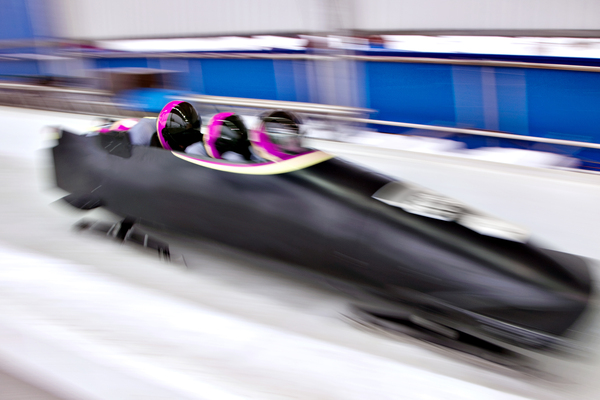Bobsleigh’s name came from the word “bob”, which means “strange, awkward movement.” Looking at the Olympic bobsleigh medalists, it is difficult to guess the etymology of the sports name, because their maneuverability on ice can hardly be called clumsy.
However, the first bobsleigh sled was very different from modern shells, their device fettered athletes, and did not allow them to achieve high speed. The same applied to the ice tracks, which were equipped worse – the surface was less slippery, the ice was not as good as it is now.

The origin and homeland of bobsleigh
Like most ice-related sports, bobsleigh originated in Switzerland. The mountainous, cold climate favored experiments on snow and ice paths. Skid structures have been known to the world for a long time, but devices such as beans, which allow you to develop high speed due to aerodynamics, were designed only at the end of the 19th century.
This sport first received an official name and recognition in 1897, when the first bobsleigh club was organized in the city of St. Moritz. In a short period of time, the direction became widespread in European resorts – the guests of the chalet and guest houses wanted to diversify their vacation and supplied various structures on the skids with a steering mechanism until in 1904 beans-bolides were put on sale.

The first countries to adopt Swiss fun sport were Germany and Austria. The first professional athletes of these countries entered international competitions with Switzerland already in 1908. Since then, other countries have begun to catch up, but so far at a semi-professional and amateur level.
It wasn’t until 1923 that bobsleigh was recognized as a professional sport. The Bobsleigh Federation was immediately created in this direction and preparations began to include bobsleigh in the program of the Olympic Games, which happened for the first time in 10 years in Lake Placid.
Development of bobsleigh sport
For the first decades, the bobsleigh remained an elite sport due to the high cost of good equipment for ice. Many amateurs and beginners began to join in the 50s, when there was an integration of athletes of this type and a number of others. Bobsledders have realized that it is not enough just to control the car, it needs to be well dispersed and prepared, and this requires a team.
Also in this period, the bobsleigh rules began to be more clearly outlined, including restrictions on the weight of the athlete. Now there is no place left in sports for obese men who gained acceleration only due to their own body weight – specialists with well-practiced movements and an analyzed strategy for ice turns, inclinations and, in general, behavior on the ice track got down to business.
Rules and varieties of bobsleigh
Despite the fact that both women and men take part in the bobsleigh competition, this discipline remains unified for both sexes. But at the performances, the teams take part separately, since the representatives have a different weight category.
The main task of the team is to make a high-speed descent from the ice mountain, while achieving the highest speed and keeping within the minimum time.
There are such types:
- races on double sleigh;
- on a four-seater sleigh.
Depending on the type of championship, there are 2 or 4 ice descents. When the competitors pass the tracks, the times of each lap are summed up. Athletes with the least time spent on passing win.
According to the age criterion, they distinguish:
- juniors – up to 26 years;
- adults – older than the specified value.
At the same time, teenagers under 18 can also compete, but only with notarized permission from their parents. This formality does not apply to children’s sports sections.
Allowed values for the mass of the equipped bean include:
- Double sleds must be at least 170 kg without a crew and not more than 390 kg (340 for the fairer sex) in full ammunition.
- Quadruples have the appropriate limits: minimum – 210 kg, maximum – 630 kg.
- This value includes weight: car; athletes; equipment. There are also requirements for championship venues.
Ice track for bobsleigh
The road in St. Moritz, the place where the sport was founded, was taken as a model. The Swiss mountains are popular for their natural relief slopes with ideal conditions for uniform ice freezing. The origin of this ice racing lap is natural. Bobsledders all over the world love this ice. But it is far from the ideal conditions that are being created at the moment.
The structure and configuration of the racing area has a complex shape with multiple bends and long sections for acceleration and finish. Not only the results of the participants depend on the correct structure, but also their health, because fireballs fly along these artificial tracks at speeds up to 100 km / h. If the walls are not high enough or the turns are too sharp, then there is a high probability of falling out of the race, which will lead to injury to the entire team.
The entire structure consists of a solid reinforced concrete base and an ice-freezing system.
The requirements for technical equipment
Motion sensors are located along the entire length on the sides, they are high-speed and measure the location of the sled in a fraction of a second. This allows for parallel races, as well as for the rivals themselves to receive information about the location of the opposing team. Cameras are mounted in a number of sections, allowing you to follow the technique of performing various movements by the participant.
A refrigeration system is installed in the gutters, which maintains the state of ice in a stable temperature regime. It is connected to the pipes through which the refrigerant passes. Such capsules are laid along the entire route.
Surface improvements can be traced at almost every Games, but they are mostly related to the development and reduction in the cost of freezing ice.
